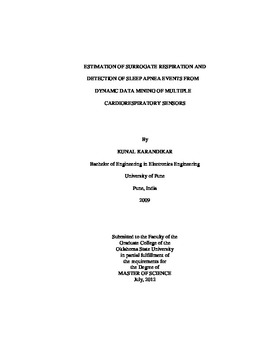| dc.contributor.advisor | Bukkapatnam, Satish | |
| dc.contributor.author | Karandikar, Kunal | |
| dc.date.accessioned | 2014-04-17T19:44:39Z | |
| dc.date.available | 2014-04-17T19:44:39Z | |
| dc.date.issued | 2012-07-01 | |
| dc.identifier.uri | https://hdl.handle.net/11244/9853 | |
| dc.description.abstract | This research investigates an approach to derive respiration waveform from heart sound signals, and compare the waveform signal obtained thus with those obtained from alternative methods for deriving respiration waveforms from measured ECG signals. The investigations indicate that HSR can lead to a cost effective alternative to the use of respiratory vests to analyze cardiorespiratory dynamics for clinical diagnostics and wellness assessments. The derived respiratory rate was further used to classify Type III sleep apnea periods using recurrence analysis. Detection of patterns causing sleep apnea could open up opportunities to researchers to better understand and predict symptoms leading to disorders linked with sleep apnea like hypertension, sudden infant death syndrome, high blood pressure and a risk of heart attack. Surrogate respiratory signals derived from heart sounds (HSR) are found to have 32% and 36% correlation with the actual respiratory signals recorded at upright and supine positions, respectively, as compared to EMD derived respiration signals (EDR) that have (18% and 26%) correlation with the respiration waveforms measured in upright and supine positions, respectively. Wavelet-derived respiration (WDR) signals show a higher wave-to-wave correlation (55% and 55%) than HSR and EDR waveforms, but the respiratory sinus arrhythmia (RSA), zero crossing intervals, and respiratory rates of the HSR correlate better with the measured values, compared with those from EDR and WDR signals. Three models were implemented using recurrence analysis to classify sleep apnea events and were compared with a vectorized time series derived model. Advanced predictive modeling tools like decision trees, neural networks and regression models were used to classify sleep apnea events form non-apneic events. Model comparison within preliminary analysis model consisting of nasal respiration as well as its time lagged components and heart rate when compared with recurrence models shows that the preliminary analysis model(vectorized time series) has a lower misclassification rate (10%) than the recurrence models( Model 1: 20% Model 2: 14%, Model 3: 12%). | |
| dc.format | application/pdf | |
| dc.language | en_US | |
| dc.publisher | Oklahoma State University | |
| dc.rights | Copyright is held by the author who has granted the Oklahoma State University Library the non-exclusive right to share this material in its institutional repository. Contact Digital Library Services at lib-dls@okstate.edu or 405-744-9161 for the permission policy on the use, reproduction or distribution of this material. | |
| dc.title | Estimation of Surrogate Respiration and Detection of Sleep Apnea Events from Dynamic Data Mining of Multiple Cardiorespiratory Sensors | |
| dc.type | text | |
| dc.contributor.committeeMember | Balasundaram, Balabhaskar | |
| dc.contributor.committeeMember | Kong, James | |
| dc.contributor.committeeMember | Benjamin, Bruce A. | |
| osu.filename | Karandikar_okstate_0664M_12335.pdf | |
| osu.college | Engineering, Architecture, and Technology | |
| osu.accesstype | Open Access | |
| dc.description.department | Industrial Engineering & Management | |
| dc.type.genre | Thesis | |
| dc.subject.keywords | heart sounds | |
| dc.subject.keywords | predictive modeling | |
| dc.subject.keywords | recurrence | |
| dc.subject.keywords | respiration | |
| dc.subject.keywords | sleep apnea | |
| dc.subject.keywords | wearable vests | |
